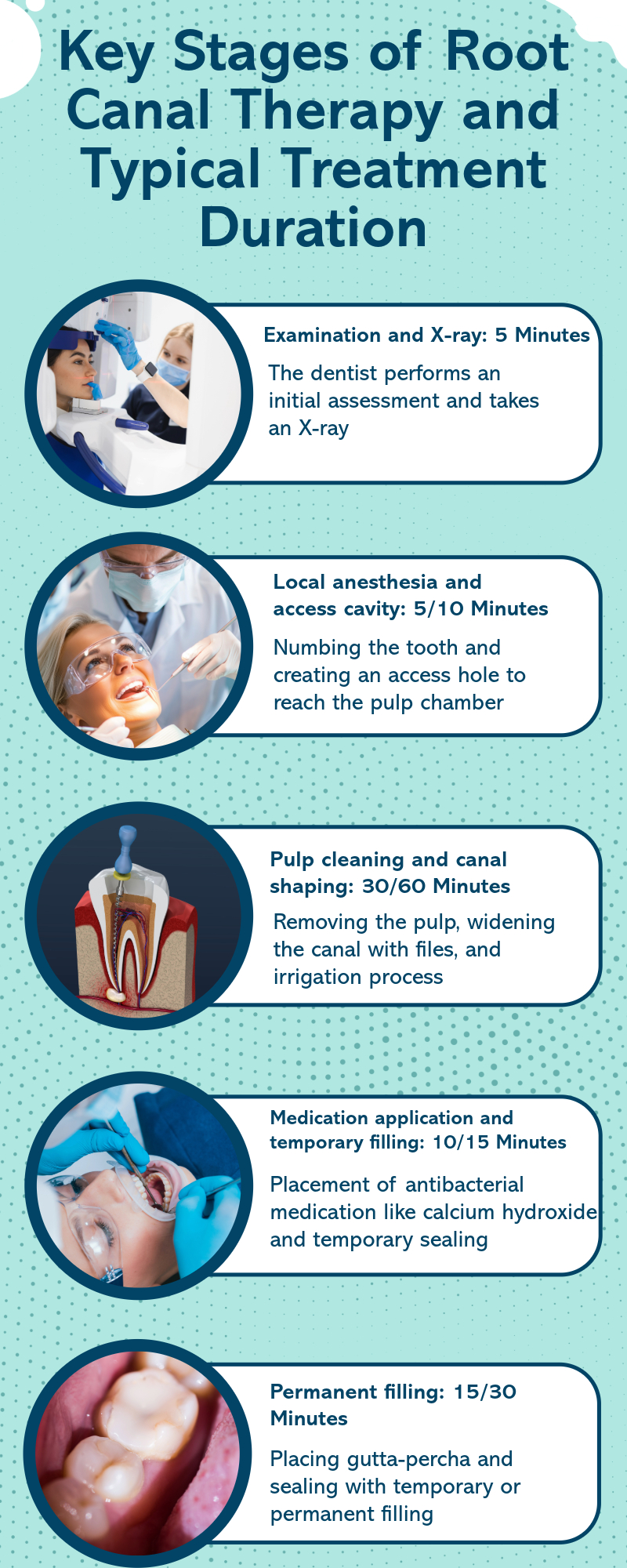Root canal therapy is one of the most effective ways to save a severely damaged or infected tooth without resorting to extraction. A root canal is a way to clean the inflamed or damaged pulp tissue inside a tooth, allowing the tooth to continue functioning, rather than removing the tooth entirely. In this way, both the natural tooth structure is preserved and the chewing function can be maintained.

In this article, we break down what root canal treatment is, why it's needed, how it's done, and how many sessions it usually takes. We also answer common questions about pain during the procedure and what to expect during recovery.
How is Root Canal Treatment Performed? (Stages)
Root canal treatment involves several careful steps, but thanks to modern techniques, it's usually painless — the tooth is numbed and the damaged nerve tissue is removed. Here's a general overview of how the procedure works:

Examination, X-ray and Anaesthesia
Firstly, the dentist examines the problematic tooth and takes x-rays to check the condition of the roots. The x-ray determines whether there is an infection or cyst at the root tip. Then the tooth and surrounding tissues are anaesthetised with local anaesthesia. (Even if the nerve of the tooth is dead, it is usually anaesthetised to relax the patient).
Entering the Tooth and Cleaning the Pulp
After cleaning the decayed part of the tooth, the dentist reaches the pulp chamber by making a small hole on the upper side. This hole is usually opened on the tongue side in the front teeth and on the chewing surface in the back teeth. The aim is to provide a straight and correct entry path to the root canals. At this stage, the infected pulp (dental nerve and vessel) is removed from the canals and no more living tissue is left in the canals.
Shaping and Disinfection of the Canals
The root canals of the tooth are cleaned and widened with special canal files (thin rasp-shaped instruments). The physician determines the exact length of the canal with the help of an electronic device (apex locator) or X-ray and removes all infected tissue up to the root tip. The canals need to be widened so that they can be properly filled. The residues and bacteria scraped off by the files during cleaning are removed by frequent irrigation (washing).
A strong antiseptic solution such as sodium hypochlorite is usually used for this purpose. In fact, this regular washing is one of the most important steps in destroying microorganisms in the canal. In addition, the physician creates a straight access path by widening the entrance at the apex of the tooth as much as necessary so that the root canal instruments can work comfortably and do not break.
Medication and Temporary Filling
If there is a widespread infection or abscess at the root of the tooth (e.g. an inflammatory discharge on the gum called a fistula), the dentist will place an antibacterial medication (usually calcium hydroxide) into the canals after cleaning them. This drug stays in the tooth for a few days to 1-2 weeks, destroying the remaining bacteria and allowing the infection to dry up. After the medication, the tooth is sealed with a temporary filling. The temporary filling prevents bacteria from re-entering the canal until the next session.
Filling the canal permanently
At the next appointment (or in some cases at the first session if there is no infection), the doctor will check the canals again. If it is confirmed that the infection is gone, the canals are filled tightly with permanent filling material. Usually rubber cones called guta percha and a special root canal cement (paste) are used to fill the root canals.
The guta percha cones are cut and placed according to the measured length of the canal and filled along the entire length of the root so that there are no gaps. The upper part of the tooth is then sealed with a permanent filling material (e.g. composite). If the structure of the tooth is very weakened, a crown may be recommended after root canal treatment to prevent future fracture.
At the end of these steps, the inside of the tooth is completely cleaned and sealed. Thus, thanks to root canal treatment, the tooth remains in the mouth and continues to function even if the nerves are removed.
How Long Does Root Canal Treatment Take? (Session Duration)
On average, it takes about an hour, but it can take anywhere from forty-five minutes to an hour and a half. Because they only have one root, front teeth are much easier to clean and fill than back teeth, which may take a little longer due to the multiple canals in molars.
In most cases, the first appointment—the one where the canals are cleaned and medicated—will last longer if the treatment is divided into two sessions. The second appointment is usually shorter because only the medication is removed from the canal and the permanent filling is placed. In any case, the total treatment time may vary depending on the condition of the tooth, the number of root canals and the extent of the infection. Following your dental exam, your dentist will give you an estimate of the total time and number of appointments needed for treatment.
Conclusion
Root canal therapy is an invaluable procedure to prevent tooth loss. Patients typically report little to no discomfort during the procedure and significant improvement in tooth-related pain following treatment, all because of the anaesthesia that is given during the procedure.
To ensure a successful root canal treatment, it is crucial to thoroughly clean and fill the inside of the tooth to seal off any potential bacteria leakage. Thanks to the careful work of your dentist, the infection remaining at the root tip will disappear over time with the body's own healing mechanisms.
